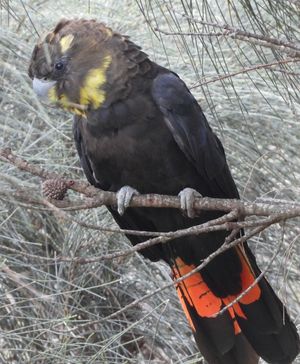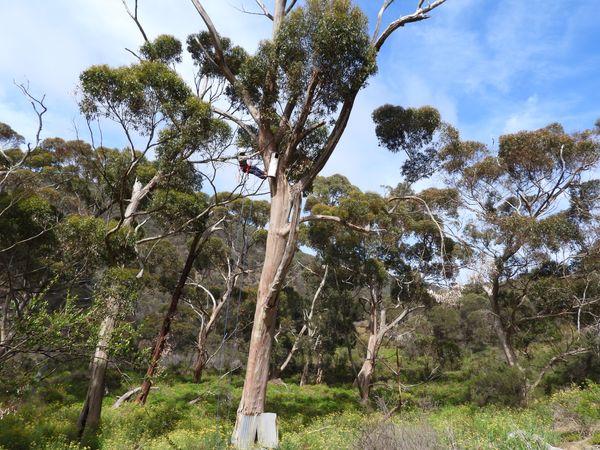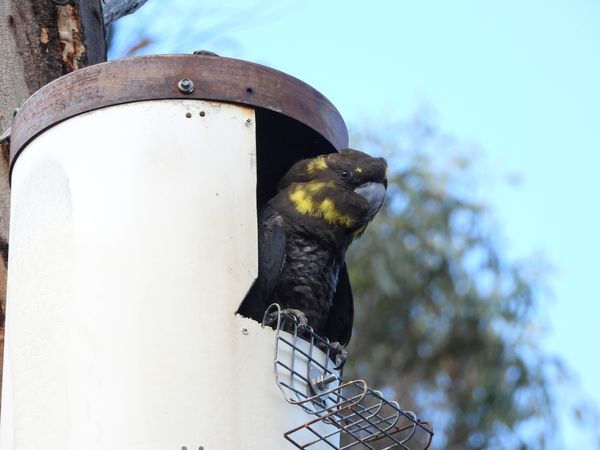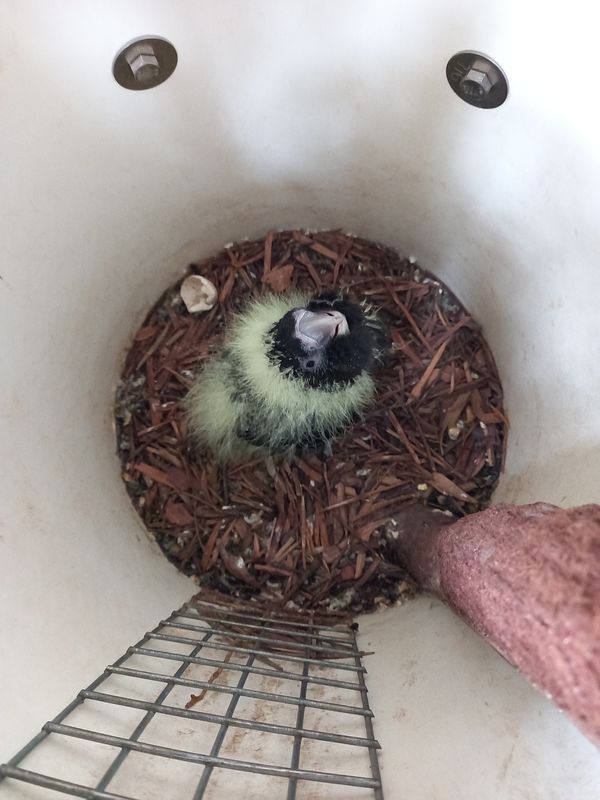 LINKED PAPER
LINKED PAPER
The influence of surrounding habitat, behaviour and interspecific competition on nestbox use by endangered Glossy Black Cockatoos (Calyptorhynchus lathami halmaturinus). Berris, K.K,, Barth, M. & Mooney, T. 2022 Ibis. doi: 10.1111/ibi.13091 VIEW
Nestboxes are widely deployed as a conservation tool for both birds and arboreal mammals, to provide nesting or den sites in areas where natural tree hollows (also known as tree cavities) may be lacking. Often nestboxes are deployed for a species of conservation concern, however the uptake of nestboxes by the target species is not always guaranteed. There are numerous examples of nestboxes being used by common or exotic species rather than the target species they were installed for (e.g. Stojanovic et al. 2021). Given nestboxes can be costly to construct and install, and generally require ongoing maintenance to keep them functional (Lindenmayer et al. 2009), it is important nestboxes are deployed in locations that maximise the likelihood they will be used by the target species.

Figure 1 Nestboxes for cockatoos are often in tall Eucalyptus trees and require conservation managers to work at heights to install and maintain them. There is often significant investment in ongoing maintenance to keep nestboxes functional for use.
The South Australian Glossy Black Cockatoo (Calyptorhynchus lathami halmaturinus) is a dietary specialist, feeding almost solely on the seeds of the Drooping Sheoak tree (Allocasuarina verticillata). Habitat loss, primarily the clearance of Drooping Sheoak woodlands, resulted in this subspecies extinction on mainland Australia, and its range is now restricted to one offshore island off the coast of South Australia (Berris et al. 2018). The island on which South Australian Glossy Black Cockatoos occur also has a history of timber logging, therefore nestboxes were installed to provide nesting habitat. However, the use of nest boxes by Glossy Black Cockatoos varied considerably between sites. Some nestboxes were used almost every breeding season by Glossy Black Cockatoos, while others had never been used despite being located close to significant patches of Drooping Sheoak woodland and regular observations made of Cockatoos feeding in the area. There had also never been a formal assessment of whether Glossy Black Cockatoos that nested in nestboxes had similar breeding success rates to those that nested in natural tree hollows.

Figure 2 A female Glossy Black Cockatoo at the entrance to a nestbox. Females readily use nest boxes, however some nestboxes are used frequently for breeding while others are seemingly ignored by the population.
In this new study, we collated 20 years of Glossy Black Cockatoo nesting data for nests in both nestboxes and naturally formed tree hollows to determine if nestboxes were an effective substitute for tree hollows. We then measured several habitat features in proximity to nestboxes to determine what factors influenced the use of nestboxes by Glossy Black Cockatoos. Static landscape features measured included the amount of Drooping Sheoak woodland (potential feeding habitat) in a 1 km and 5 km radius of nest boxes, and the amount of other large Eucalyptus tree woodland (potential nesting habitat) in a 1 km radius as a proxy for potential hollow availability. Other features, such as the presence of competitors or other nesting Glossy Black Cockatoos changed year by year. Therefore we also compiled data between 2013 and 2017 on the use of nestboxes by Yellow-Tailed Black Cockatoos, a potential nest competitor, the distance of each nestbox to the nearest other Glossy Black Cockatoo nest each year, and the number of other Glossy Black Cockatoos that nested in a 1 km radius of nestboxes each year.
Video 1 Australian Birds. Glossy Black Cockatoo family calling and feeding © Tim Siggs.
Our results showed that breeding success in nestboxes was the same as in natural tree hollows for Glossy Black Cockatoos (Zanda funerea), indicating nestboxes are not having an adverse impact on breeding success in this species and are an effective substitute for a lack of natural tree hollows. To our surprise, the amount of Drooping Sheoak feeding habitat in a 1 km and 5 km radius did not significantly influence nestbox use, despite this species being a dietary specialist. This could be because all nestboxes surveyed were within 10km of potential feeding habitat, and this large Cockatoo is capable of flying some distance to access food sources. However, nestboxes were more likely to be used if they were close to another active Glossy Black Cockatoo nest. In fact, for every 1km increase in distance from another Glossy Black Cockatoo nest the likelihood of use of a nestbox decreased by 71%. Nestboxes were also much more likely to be used if they had been used by Glossy Black Cockatoos in the previous nesting season, indicating nest site fidelity. Competition also played an important role in nestbox use; Glossy Black Cockatoos were 86% less likely to use a nestbox if it was occupied by Yellow-Tailed Black Cockatoos early in their breeding season. There is an overlap in breeding seasons of these two cockatoo species, and our results indicate that rather than wait for a Yellow-tailed Black Cockatoo to finish nesting, Glossy Black Cockatoos will seek out another nesting site in response to competition.

Figure 3 A Glossy Black Cockatoo nestling in a nestbox. Nestboxes and natural tree hollows have similar breeding success rates, indicating nestboxes are an effective substitute for natural hollows.
Our study indicates that nestboxes can be an important tool in cockatoo conservation programs, but in flocking or social species we should consider the preferred social groupings of a target species when installing nestboxes. Our research also provides further evidence that competition with other hollow-nesting species can have a significant impact on the occupancy of nestboxes by a target species. Ideally, for Glossy Black Cockatoos we should install nestboxes in areas where Yellow-Tailed Black Cockatoos are less abundant. However given they are a dietary generalist and are widespread across the range of Glossy Black Cockatoos this is not always possible. However we can install nestboxes close to other nesting Glossy Black Cockatoo pairs. There are several potential possible reasons that Glossy Black Cockatoos prefer nesting in a clustered fashion. It could be that social flock bonds drive clustered nesting, and indeed flocking behaviour is observed in this species outside of the breeding season. Clustered nesting may also mean that nesting pairs have company when travelling between feeding and nesting sites, which may reduce the risk of predation by raptors. Although we are not sure exactly why Glossy Black Cockatoos prefer nesting in a clustered fashion, the social lives of these long-lived and charismatic cockatoos is worthy of further study.

Figure 4 A Yellow-tailed Black Cockatoo in a nest box installed for Glossy Black Cockatoos. Occupancy by Yellow-tailed Black Cockatoos significantly reduced the likelihood of Glossy Black Cockatoos using a nestbox.
References
Berris, K.K., Barth, M., Mooney, T., Paton, D., Kinloch, M., Copley, P., Maguire, A., Crowley, G. & Garnett, S.T. 2018. From the brink of extinction: successful recovery of the glossy black-cockatoo on Kangaroo Island. In Garnett, S., Latch, P., Lindenmayer, D. & Woinarski, J. (eds) Recovering Australian Threatened Species: A Book of Hope. 75–84. Clayton South: CSIRO Publishing.
Lindenmayer, D.B., Welsh, A., Donnelly, C., Crane, M., Michael, D., Macgregor, C., McBurney, L., Montague-Drake, R. & Gibbons, P. 2009. Are nest boxes a viable alternative source of cavities for hollow-dependent animals? Long-term monitoring of nest box occupancy, pest use and attrition. Biological Conservation 142: 33-42. VIEW
Stojanovic, D., Owens, G., Young, C.M., Alves, F. & Heinsohn, R. 2021. Do nest boxes breed the target species or its competitors? A case study of a critically endangered bird. Restoration Ecology 29: e13319. VIEW
Image credit
Top right: A female Glossy Black Cockatoo Calyptorhynchus lathami halmaturinus © Karleah Berris.
If you want to write about your research in #theBOUblog, then please see here.



